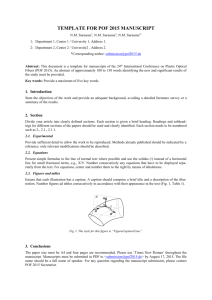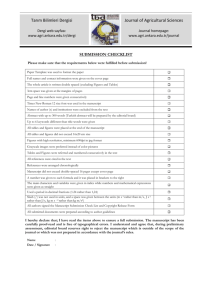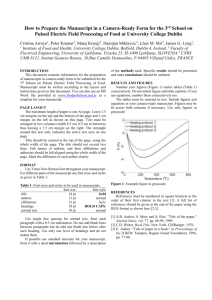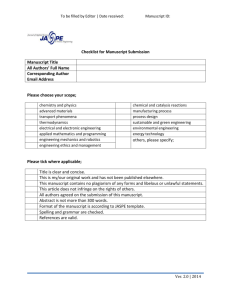Camera-ready Manuscript for the Proceedings of ASDAM`02
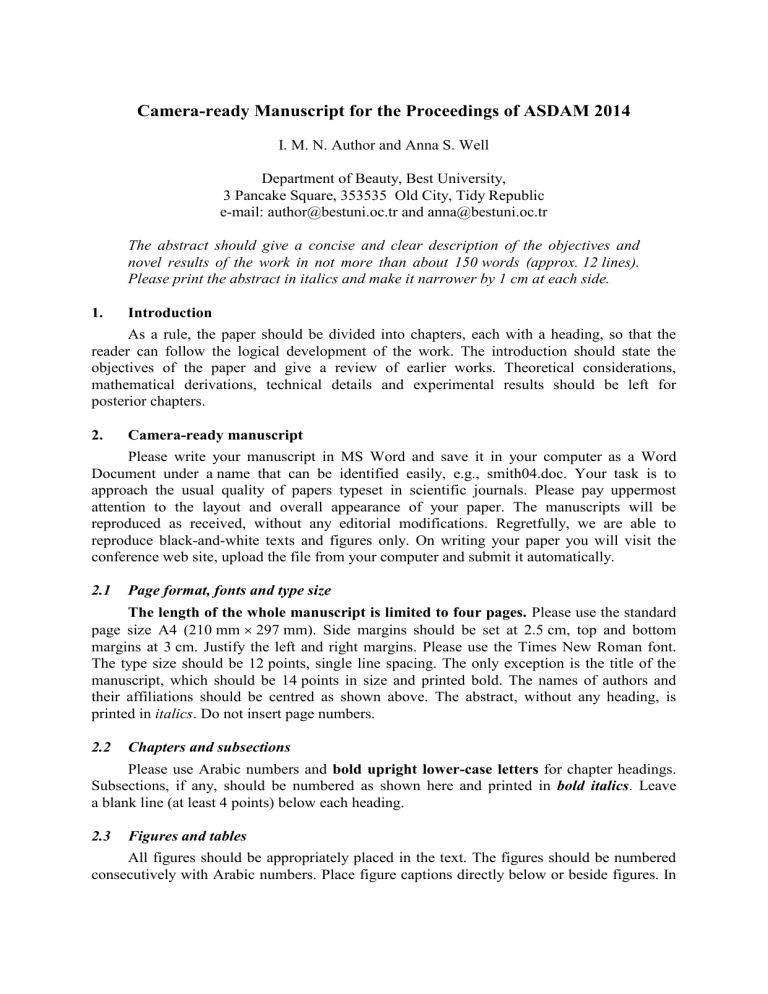
Camera-ready Manuscript for the Proceedings of ASDAM 2014
I. M. N. Author and Anna S. Well
Department of Beauty, Best University,
3 Pancake Square, 353535 Old City, Tidy Republic e-mail: author@bestuni.oc.tr and anna@bestuni.oc.tr
The abstract should give a concise and clear description of the objectives and novel results of the work in not more than about 150 words (approx. 12 lines).
Please print the abstract in italics and make it narrower by 1 cm at each side.
1. Introduction
As a rule, the paper should be divided into chapters, each with a heading, so that the reader can follow the logical development of the work. The introduction should state the objectives of the paper and give a review of earlier works. Theoretical considerations, mathematical derivations, technical details and experimental results should be left for posterior chapters.
2. Camera-ready manuscript
Please write your manuscript in MS Word and save it in your computer as a Word
Document under a name that can be identified easily, e.g., smith04.doc. Your task is to approach the usual quality of papers typeset in scientific journals. Please pay uppermost attention to the layout and overall appearance of your paper. The manuscripts will be reproduced as received, without any editorial modifications. Regretfully, we are able to reproduce black-and-white texts and figures only. On writing your paper you will visit the conference web site, upload the file from your computer and submit it automatically.
2.1 Page format, fonts and type size
The length of the whole manuscript is limited to four pages.
Please use the standard page size A4 (210 mm
297 mm). Side margins should be set at 2.5 cm, top and bottom margins at 3 cm. Justify the left and right margins. Please use the Times New Roman font.
The type size should be 12 points, single line spacing. The only exception is the title of the manuscript, which should be 14 points in size and printed bold. The names of authors and their affiliations should be centred as shown above. The abstract, without any heading, is printed in italics . Do not insert page numbers.
2.2 Chapters and subsections
Please use Arabic numbers and bold upright lower-case letters for chapter headings.
Subsections, if any, should be numbered as shown here and printed in bold italics . Leave a blank line (at least 4 points) below each heading.
2.3 Figures and tables
All figures should be appropriately placed in the text. The figures should be numbered consecutively with Arabic numbers. Place figure captions directly below or beside figures. In
figure captions, try to use words and symbols rather than symbols alone. For example, write the quantity as “layer thickness d
”, not just “ d
”. Symbols standing for physical quantities should be printed in italics . Axis labels, especially multipliers may often be a source of confusion. Units should be written in round brackets. Write “ d
(nm)” or “ d (10
–9
m)”, not
“ d
10
–9
(m)”. Please remember that the manuscript will be reduced to about 70%, therefore figure labels should be large enough to be legible upon reduction. Similarly like figures, all tables should be numbered in Arabic numbers and placed at their appropriate places in the text.
2.4 Equations and units
If possible, use an equation editor to create your mathematical formulae. The main symbols should have a size of 12 points. Italicize the symbols standing for quantities and variables but not for mathematical functions (sin, cos, exp, etc .) and units. Punctuate equations with commas or full stops when they are part of sentences, like in this case:
n
p
p
. (1)
Indent the equations by 1 cm from the left margin and number them consecutively with Arabic numbers in round brackets at the right margin, as in Eqn. (1).
Use the International System of Units (SI) only. Never combine SI units and CGS or other units. Define abbreviations and acronyms the first time they are used in the text.
2.5 Citations
Number the references consecutively in square brackets [1, 2]. Do not use “Ref. [3]” or
“reference [3]” except at the beginning of a sentence. Give all authors’ names; do not use
“ et al.
” unless there are six authors or more. Papers that have not been published yet, should be cited as “unpublished”, see [4]. Papers that have been accepted for publication should be cited as “in press” or “in print” [5].
3. Other recommendations
Remember that the manuscript will be off-printed as received. If possible, use an automatic spell-checker. If your mother tongue is not English, try to get a native Englishspeaking colleague to correct the text.
Acknowledgement
Careful consideration and obeying of these guidelines is gratefully acknowledged by the editors of the Conference Proceedings.
References
[1] S. M. Sze, Physics of Semiconductor Devices , John Wiley & Sons, New York, 1981.
[2] D. Y. Chen, Y. A. Chang, and D. Swenson, Appl. Phys. Lett . 68 , 96, 1996.
[3] G. Birch, P. Maple, and F. Oak, in Proceedings of the ASDAM’96 Conference ,
Smolenice, Slovakia, 2000, p. 3.
[4] F. Novák, unpublished.
[5] M. Smith, Surface Sci.
, in press.




